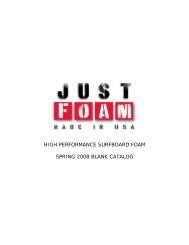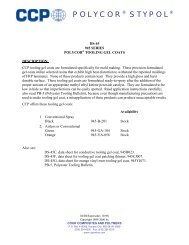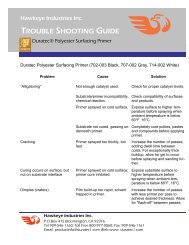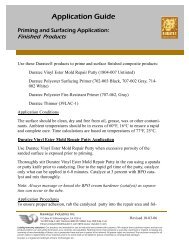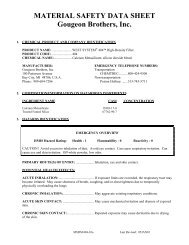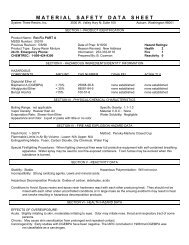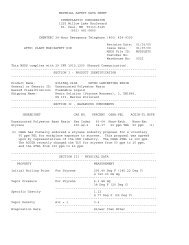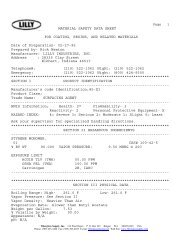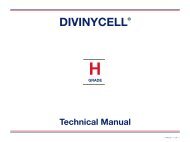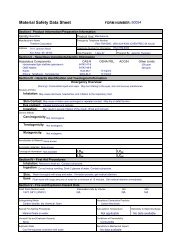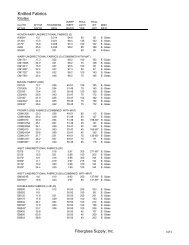MATERIAL SAFETY DATA SHEET - Fiberglass Supply
MATERIAL SAFETY DATA SHEET - Fiberglass Supply
MATERIAL SAFETY DATA SHEET - Fiberglass Supply
You also want an ePaper? Increase the reach of your titles
YUMPU automatically turns print PDFs into web optimized ePapers that Google loves.
SWALLOWING<br />
INHALATION<br />
SKIN CONTACT<br />
EYE CONTACT<br />
NOTES TO PHYSICIAN<br />
: No emergency care anticipated.<br />
: No emergency care anticipated.<br />
: Remove contaminated clothing. Wash skin with soap and water. Obtain medical attention if<br />
irritation persists. Wash clothing before reuse.<br />
: Immediately flush eyes with water and continue washing several minutes. Obtain medical<br />
attention if discomfort persists.<br />
: There is no specific antidote. Treatment or overexposure should be directed at the control of<br />
symptoms and the clinical condition of the patient.<br />
5.0 FIRE-FIGHTING MEASURES<br />
5.1 EXTINGUISHING MEDIA<br />
Apply alcohol type or all purpose type foams by manufacturer’s recommended technique for large fires. Use carbon monoxide or dry<br />
chemical media for small fires.<br />
5.2 EXTINGUISHING MEDIA TO BE AVOIDED<br />
None<br />
5.3 SPECIAL FIRE FIGHTING PROCEDURES<br />
Do not direct a solid stream of water or foam into burning molten material; this may cause spattering and spread of fire.<br />
5.4 SPECIAL PROTECTIVE EQUIPMENT FOR FIRE FIGHTERS<br />
Use self-contained breathing apparatus and protective coating.<br />
5.5 UNUSUAL FIRE AND EXPLOSION HAZARDS<br />
Avoid dispersion of dust in air to reduce potential of dust ignition/explosions. Formaldehyde and phenol may form under fire conditions.<br />
6.0 ACCIDENTAL RELEASE MEASURE<br />
Wear suitable protective clothing. Collect for disposal.<br />
7.0 HANDLING AND STORAGE<br />
7.1 HANDLING<br />
7.1.1 GENERAL PRECAUTION : Avoid dispersion of dust in air.<br />
: Avoid sparks and flame under dust conditions.<br />
: Use with adequate ventilation.<br />
: Electrically bond and ground all equipment.<br />
: Avoid contact with skin. In case of contact with eyes, rinse immediately with plenty of<br />
water and call the physician if necessary.<br />
7.1.2 VENTILATION : Special, local ventilation is recommended in areas where containers are opened and<br />
their contents are discharged or in any other areas where dusting conditions may develop.<br />
7.1.3 OTHER PRECAUTION : [CAUTION] May undergo spontaneous smouldering if stored or heated in bulk<br />
above 35 C under conditions allowing air ingress to the product. Store package<br />
material in a cool, well ventilated area.<br />
: Do not store in the sun.<br />
: Do not dry in package - use special drying instructions as in 7.1.4.<br />
: Microspheres will undergo oxidation at elevated temperatures. Due to the microspheres’<br />
excellent insulating characteristics, the internal temperature of the mass can increase to the<br />
point where spontaneous ignition and smouldering can occur. The temperature at which this<br />
occur is a function of the geometry, amount of material being heated and available oxygen.<br />
Smouldering appears as a soft glow similar to burning charcoal.<br />
MSDSUS Page 3 of 5<br />
7.1.4 DRYING INSTRUCTIONS FOR : To reduce the moisture content of this product to less than 4%, dry a two inch<br />
THERMOSET MICROSPHERES<br />
layer or less of the product at a maximum temperature of 75 C for 24 hours. To



